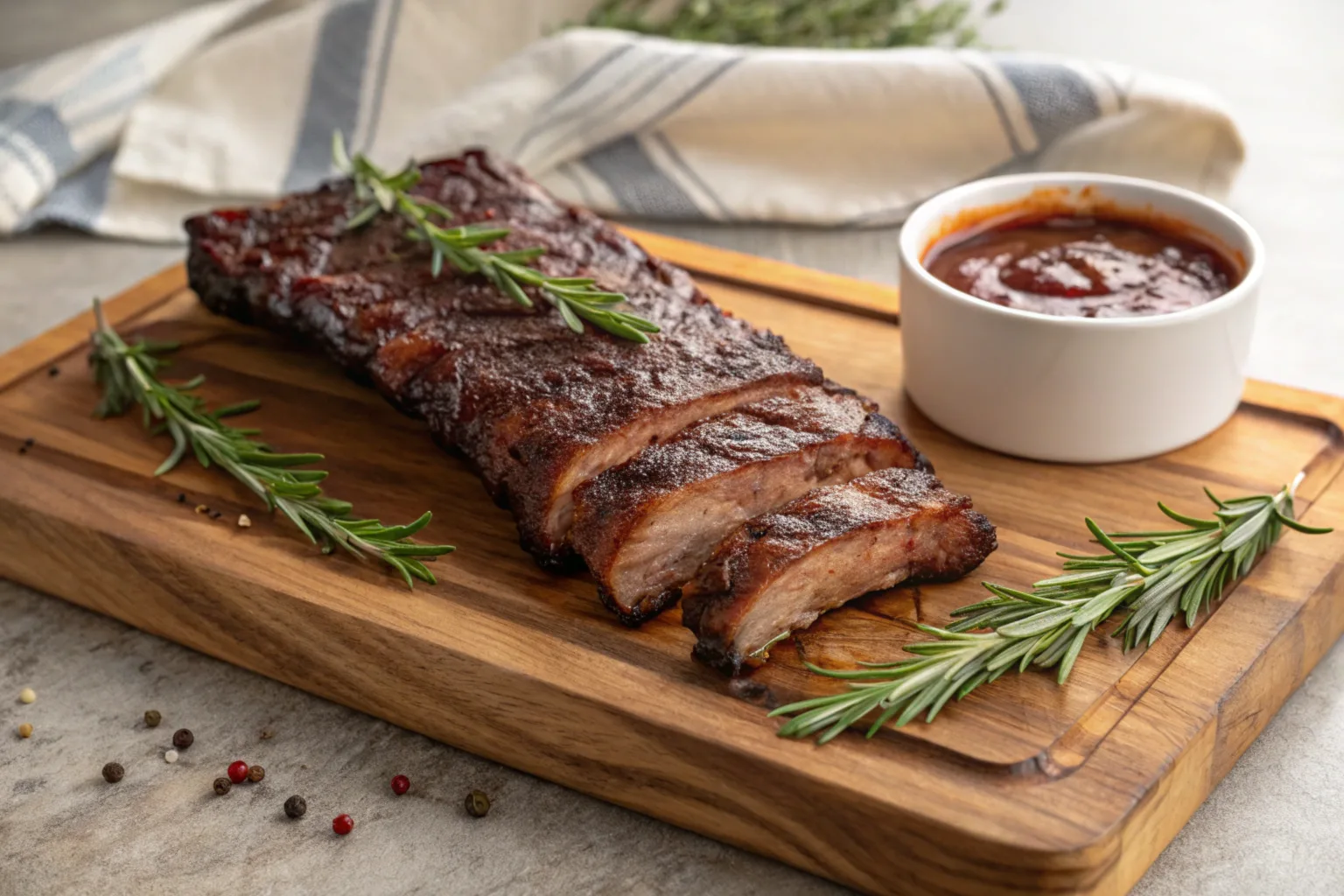A Quick Overview of the Article
Beef back ribs are a flavorful, yet often overlooked, cut of meat. This article explores whether beef back ribs are a good cut, comparing them with short ribs, discussing cooking methods, and answering common questions about preparing and serving this delicious cut.
Table of Contents
What Are Beef Back Ribs?
Beef back ribs are a hidden gem in the meat world. They come from the upper part of the cow’s ribcage, right behind the prime rib roast. These ribs are long, slender, and packed with rich, meaty flavor. Though they don’t have as much meat as short ribs, their bold beefy taste makes them a favorite among BBQ enthusiasts.
Many home cooks shy away from beef back ribs, thinking they’re tough or difficult to prepare. However, with the right know-how, they can become the centerpiece of a mouthwatering meal. Whether you’re firing up the grill or slow-cooking in the oven, beef back ribs offer a culinary adventure like no other.
Understanding Beef Back Ribs
What Makes Beef Back Ribs Unique?
Beef back ribs are one of the most flavorful cuts you can get from a cow. Unlike short ribs, which are meatier, beef back ribs offer a more intense beefy taste. This cut comes from the back section of the ribcage, just behind the prime rib. The bones are long, curved, and lined with marbled meat, which melts into juicy tenderness when cooked properly.
What makes beef back ribs truly shine is their ability to absorb smoky flavors during cooking. Though the meat sits between the bones rather than on top, its bold, beef-forward taste makes up for the lower meat content. With the right seasoning and slow-cooking method, you can transform these ribs into a tender, fall-off-the-bone treat.
For more details on cooking techniques, check out this MasterClass guide on beef back ribs.
Beef Back Ribs vs. Short Ribs
While both cuts come from the cow’s rib section, beef back ribs and short ribs couldn’t be more different. Beef back ribs are cut from the upper ribcage, while short ribs are taken from the lower part near the belly. Short ribs are chunkier and meatier, making them a popular choice for slow-cooked stews and braises.
On the flip side, beef back ribs are thinner but have more exposed bone, which means better smoke and seasoning penetration. If you’re wondering, “Are beef back ribs a good cut?” the answer lies in how you plan to cook them. For grilling or smoking, beef back ribs are perfect due to their rich flavor and tender texture.
Learn more from this comparison article on beef rib cuts.
Are Beef Back Ribs a Good Cut for BBQ?
Absolutely! Beef back ribs shine when prepared on a BBQ smoker. The rich marbling ensures that the meat stays juicy, even after long hours of smoking. A dry rub with salt, pepper, and garlic powder is enough to enhance their robust flavor. If you prefer a smoky and caramelized crust, try basting them with BBQ sauce during the last hour of cooking.
Want to try a great recipe? Follow this Meat Church BBQ beef back ribs guide for expert tips on seasoning and smoking techniques.
Cooking Techniques & Recipes
Cooking Methods for Beef Back Ribs
There are several ways to cook beef back ribs, each delivering delicious results:
- Smoking: Ideal for maximum flavor. Use wood like oak or hickory to create a deep, smoky taste. Smoke low and slow at 225°F for 4-6 hours.
- Grilling: For a quicker option, grill over medium heat for 1-2 hours. Flip the ribs often to avoid burning.
- Braising: If you want ultra-tender meat, slow-cook ribs in a flavorful broth for 3-4 hours in the oven or slow cooker.
Check out this MasterClass guide to oven-baking beef ribs for step-by-step instructions.
How to Select and Prepare Beef Back Ribs
To make sure you get the best ribs:
- Choose Fresh Cuts: Look for ribs with visible marbling and a rich red color. Avoid those with too much fat or a dull appearance.
- Trim the Ribs: Remove the tough membrane on the back and trim any excess fat. This helps the seasoning penetrate better.
- Season Generously: Use a dry rub with spices like paprika, garlic powder, and cayenne pepper. Let the ribs marinate for at least an hour, or overnight for deeper flavor.
Recipe Suggestions
- Signature Smoked Beef Back Ribs:
- Prep: Trim, season, and let the ribs rest for 2 hours.
- Cook: Smoke for 6 hours at 225°F, basting with BBQ sauce halfway through.
- Grilled BBQ Beef Back Ribs:
- Prep: Season with a dry rub and let sit for 1 hour.
- Cook: Grill on medium heat for 90 minutes, flipping every 20 minutes.
For more recipe inspiration, check out this BBQ Brethren forum on beef ribs.
Pros & Cons of Beef Back Ribs
Advantages of Beef Back Ribs
Beef back ribs are a hidden treasure for BBQ lovers and meat enthusiasts. Their rich flavor, juicy texture, and affordable price make them an excellent choice for home cooks and seasoned grill masters alike. Here’s a closer look at what makes beef back ribs so special:
1. Rich Flavor and Marbling
One of the standout qualities of beef back ribs is their bold, beefy flavor. Since they are cut from the prime rib section, they inherit the same intense marbling found in pricier steaks like ribeye. As the ribs cook, this marbling melts into the meat, keeping it juicy and tender while enhancing its natural taste. The result is a delicious, smoky flavor that no other cut can match.
2. Budget-Friendly Option
Compared to cuts like brisket, prime rib, or ribeye steak, beef back ribs are significantly cheaper. This makes them an appealing option for feeding large groups without breaking the bank. While they don’t have as much meat as short ribs, the savings you get on cost-per-pound makes them an economical choice for parties, backyard BBQs, and family dinners.
3. Cooking Versatility
Beef back ribs are incredibly versatile when it comes to cooking methods. You can:
- Smoke them low and slow for a deep, smoky flavor.
- Grill them over medium heat for a quick and tasty option.
- Braise them in a rich broth for fall-off-the-bone tenderness.
Whether you’re craving sticky BBQ ribs or smoky dry-rubbed ribs, beef back ribs can be prepared to match your preferred style.
4. Ideal for Outdoor Cooking
These ribs shine on the smoker or grill. Their bone structure allows for better heat and smoke circulation, which helps create a perfect smoky crust (also known as bark). Plus, the exposed bones make them easy to handle on the grill.
5. Crowd-Pleasing Presentation
Beef back ribs have a show-stopping appearance. Their long, curved bones and caramelized crust make for an impressive centerpiece at any BBQ gathering. The delicious aroma they release while cooking is guaranteed to make mouths water.
Pro Tip:
For an extra flavor boost, try adding a homemade BBQ sauce during the final 30 minutes of cooking. This creates a sticky, caramelized coating that’s hard to resist.
Check out this Cheesy Double Beef Burrito Recipe for another beef-based dish you’ll love.
Disadvantages of Beef Back Ribs
While beef back ribs have plenty of advantages, they also come with a few challenges. Here’s what you need to know before adding them to your next cookout menu:
1. Less Meat Per Rib
One common drawback of beef back ribs is their low meat-to-bone ratio. Since the meat comes from the rib section behind the prime rib, much of the muscle meat is already used in ribeye steaks or prime rib roasts. This leaves behind thin strips of meat between the bones, meaning you’ll need several ribs to make a satisfying meal.
2. Tough Texture if Cooked Incorrectly
Beef back ribs are known for their chewy texture if they aren’t cooked properly. Because of the tough connective tissues and dense muscle fibers, they require low-and-slow cooking to break down the meat into something succulent and tender. Rushing the process can leave you with tough, rubbery ribs.
3. Time-Intensive Cooking Process
Cooking beef back ribs is not a quick fix. Smoking can take up to 6 hours, while braising or oven-baking can take 3-4 hours. If you’re looking for a quick weeknight meal, these ribs may not be the best choice. However, the end result is well worth the wait when cooked correctly.
4. Requires Careful Preparation
Beef back ribs need a bit of prep work. This includes:
- Removing the membrane: The tough silver skin on the back of the ribs must be removed for better tenderness and seasoning absorption.
- Trimming excess fat: While some fat is good for flavor, too much can cause flare-ups when grilling.
Conclusion
Beef back ribs may not be the first cut that comes to mind when you think of a delicious BBQ feast, but they’re definitely worth a try. Their rich flavor, tender meat, and affordable price make them a hidden gem in the world of beef cuts. Although they require a bit of patience and the right cooking method, the results are undeniably satisfying.
If you’re wondering, “Are beef back ribs a good cut?” the answer depends on how much effort you’re willing to invest. If you enjoy slow-cooking or smoking meats, you’ll find these ribs to be incredibly rewarding. Their deep, savory taste and finger-licking-good texture will have you coming back for more.
Final Tips for Cooking Beef Back Ribs
- Prep Matters: Always trim excess fat and remove the tough membrane for better seasoning absorption.
- Season Generously: Use a flavorful rub with salt, pepper, garlic powder, and paprika.
- Cook Low and Slow: Whether you smoke, grill, or braise, patience is key for tender results.
Serving Ideas and Side Pairings
To make your meal even more memorable, pair beef back ribs with hearty sides like baked potatoes, coleslaw, or even a broccoli casserole. Need more side ideas? Check out this delicious Broccoli Casserole Recipe for a perfect complement.
Whether you’re a BBQ novice or a seasoned pitmaster, beef back ribs offer a flavor-packed experience that’s hard to beat. So, grab your apron, fire up the smoker, and get ready for a tasty adventure! 🍖🔥

